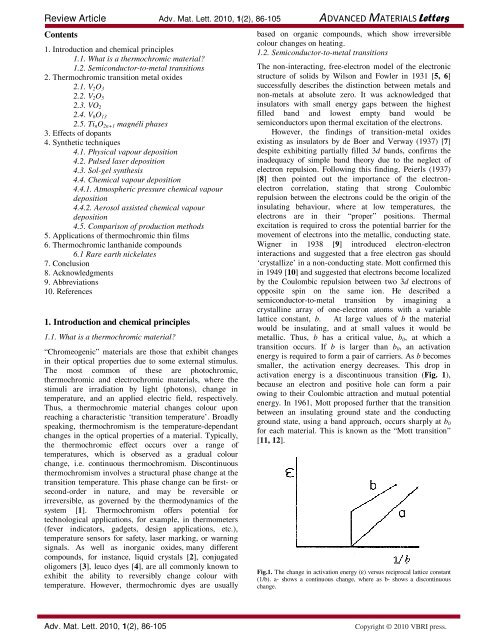Solid state thermochromic materials - Advanced Materials Letters
Solid state thermochromic materials - Advanced Materials Letters
Solid state thermochromic materials - Advanced Materials Letters
Create successful ePaper yourself
Turn your PDF publications into a flip-book with our unique Google optimized e-Paper software.
Review Article Adv. Mat. Lett. 2010, 1(2), 86-105 ADVANCED MATERIALS <strong>Letters</strong><br />
Contents<br />
1. Introduction and chemical principles<br />
1.1. What is a <strong>thermochromic</strong> material?<br />
1.2. Semiconductor-to-metal transitions<br />
2. Thermochromic transition metal oxides<br />
2.1. V2O3<br />
2.2. V2O5<br />
2.3. VO2<br />
2.4. V6O13<br />
2.5. TinO2n+1 magnéli phases<br />
3. Effects of dopants<br />
4. Synthetic techniques<br />
4.1. Physical vapour deposition<br />
4.2. Pulsed laser deposition<br />
4.3. Sol-gel synthesis<br />
4.4. Chemical vapour deposition<br />
4.4.1. Atmospheric pressure chemical vapour<br />
deposition<br />
4.4.2. Aerosol assisted chemical vapour<br />
deposition<br />
4.5. Comparison of production methods<br />
5. Applications of <strong>thermochromic</strong> thin films<br />
6. Thermochromic lanthanide compounds<br />
6.1 Rare earth nickelates<br />
7. Conclusion<br />
8. Acknowledgments<br />
9. Abbreviations<br />
10. References<br />
1. Introduction and chemical principles<br />
1.1. What is a <strong>thermochromic</strong> material?<br />
“Chromeogenic” <strong>materials</strong> are those that exhibit changes<br />
in their optical properties due to some external stimulus.<br />
The most common of these are photochromic,<br />
<strong>thermochromic</strong> and electrochromic <strong>materials</strong>, where the<br />
stimuli are irradiation by light (photons), change in<br />
temperature, and an applied electric field, respectively.<br />
Thus, a <strong>thermochromic</strong> material changes colour upon<br />
reaching a characteristic ‘transition temperature’. Broadly<br />
speaking, thermochromism is the temperature-dependant<br />
changes in the optical properties of a material. Typically,<br />
the <strong>thermochromic</strong> effect occurs over a range of<br />
temperatures, which is observed as a gradual colour<br />
change, i.e. continuous thermochromism. Discontinuous<br />
thermochromism involves a structural phase change at the<br />
transition temperature. This phase change can be first- or<br />
second-order in nature, and may be reversible or<br />
irreversible, as governed by the thermodynamics of the<br />
system [1]. Thermochromism offers potential for<br />
technological applications, for example, in thermometers<br />
(fever indicators, gadgets, design applications, etc.),<br />
temperature sensors for safety, laser marking, or warning<br />
signals. As well as inorganic oxides, many different<br />
compounds, for instance, liquid crystals [2], conjugated<br />
oligomers [3], leuco dyes [4], are all commonly known to<br />
exhibit the ability to reversibly change colour with<br />
temperature. However, <strong>thermochromic</strong> dyes are usually<br />
based on organic compounds, which show irreversible<br />
colour changes on heating.<br />
1.2. Semiconductor-to-metal transitions<br />
The non-interacting, free-electron model of the electronic<br />
structure of solids by Wilson and Fowler in 1931 [5, 6]<br />
successfully describes the distinction between metals and<br />
non-metals at absolute zero. It was acknowledged that<br />
insulators with small energy gaps between the highest<br />
filled band and lowest empty band would be<br />
semiconductors upon thermal excitation of the electrons.<br />
However, the findings of transition-metal oxides<br />
existing as insulators by de Boer and Verway (1937) [7]<br />
despite exhibiting partially filled 3d bands, confirms the<br />
inadequacy of simple band theory due to the neglect of<br />
electron repulsion. Following this finding, Peierls (1937)<br />
[8] then pointed out the importance of the electronelectron<br />
correlation, stating that strong Coulombic<br />
repulsion between the electrons could be the origin of the<br />
insulating behaviour, where at low temperatures, the<br />
electrons are in their “proper” positions. Thermal<br />
excitation is required to cross the potential barrier for the<br />
movement of electrons into the metallic, conducting <strong>state</strong>.<br />
Wigner in 1938 [9] introduced electron-electron<br />
interactions and suggested that a free electron gas should<br />
‘crystallize’ in a non-conducting <strong>state</strong>. Mott confirmed this<br />
in 1949 [10] and suggested that electrons become localized<br />
by the Coulombic repulsion between two 3d electrons of<br />
opposite spin on the same ion. He described a<br />
semiconductor-to-metal transition by imagining a<br />
crystalline array of one-electron atoms with a variable<br />
lattice constant, b. At large values of b the material<br />
would be insulating, and at small values it would be<br />
metallic. Thus, b has a critical value, b0, at which a<br />
transition occurs. If b is larger than b0, an activation<br />
energy is required to form a pair of carriers. As b becomes<br />
smaller, the activation energy decreases. This drop in<br />
activation energy is a discontinuous transition (Fig. 1),<br />
because an electron and positive hole can form a pair<br />
owing to their Coulombic attraction and mutual potential<br />
energy. In 1961, Mott proposed further that the transition<br />
between an insulating ground <strong>state</strong> and the conducting<br />
ground <strong>state</strong>, using a band approach, occurs sharply at b0<br />
for each material. This is known as the “Mott transition”<br />
[11, 12].<br />
Fig.1. The change in activation energy (ε) versus reciprocal lattice constant<br />
(1/b). a- shows a continuous change, where as b- shows a discontinuous<br />
change.<br />
Adv. Mat. Lett. 2010, 1(2), 86-105 Copyright © 2010 VBRI press.
















